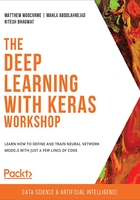
Summary
In this chapter, we covered how to prepare data and construct machine learning models. We achieved this by utilizing Python and libraries such as pandas and scikit-learn. We also used the algorithms in scikit-learn to build our machine learning models.
Then, we learned how to load data into Python, as well as how to manipulate data so that a machine learning model can be trained on the data. This involved converting all the columns into numerical data types. We also created a basic logistic regression classification model using scikit-learn algorithms. We pided the dataset into training and test datasets and fit the model to the training dataset. We evaluated the performance of the model on the test dataset using the model evaluation metrics, that is, accuracy, precision, recall, and fscore.
Finally, we iterated on this basic model by creating two models with different types of regularization for the model. We utilized cross-validation to determine the optimal parameter to use for the regularization parameter.
In the next chapter, we will use these same concepts to create the model using the Keras library. We will use the same dataset and attempt to predict the same target value for the same classification task. By doing so, we will learn how to use regularization, cross-validation, and model evaluation metrics when fitting our neural network to the data.